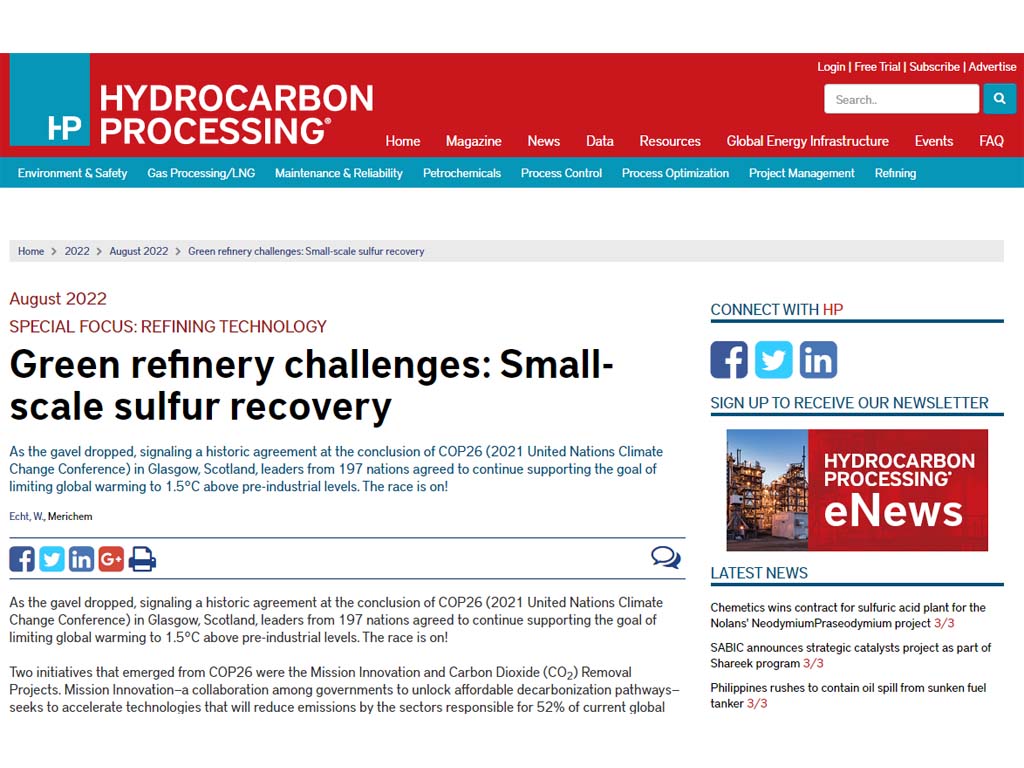SPECIAL FOCUS: REFINING TECHNOLOGY
Green refinery challenges: Small-scale sulfur recovery

As the gavel dropped, signaling a historic agreement at the conclusion of COP26 (2021 United Nations Climate Change Conference) in Glasgow, Scotland, leaders from 197 nations agreed to continue supporting the goal of limiting global warming to 1.5°C above pre-industrial levels. The race is on!
As the gavel dropped, signaling a historic agreement at the conclusion of COP26 (2021 United Nations Climate Change Conference) in Glasgow, Scotland, leaders from 197 nations agreed to continue supporting the goal of limiting global warming to 1.5°C above pre-industrial levels. The race is on!
Two initiatives that emerged from COP26 were the Mission Innovation and Carbon Dioxide (CO2) Removal Projects. Mission Innovation—a collaboration among governments to unlock affordable decarbonization pathways—seeks to accelerate technologies that will reduce emissions by the sectors responsible for 52% of current global emissions. The Netherlands and India are leading a biorefinery program to make bio-based alternative fuels and chemicals economically attractive. The other initiative is the Carbon Dioxide Removal Project, which is led by Saudi Arabia, the U.S. and Canada. The project’s goal is to net an annual reduction of 100 MMtpy of CO2 by 2030. Other countries are following suit.
The biggest culprit
In November 2021, the Global Carbon Project, a Global Research Project of Future Earth and a research partner of the World Climate Research Programme, reported that global CO2 emissions from fossil fuels were 34.8 GtCO2, a decrease of 5.4% from 36.7 GtCO2 in 2019; however, projected global fossil CO2 emissions in 2021 were forecast to rebound close to their pre-COVID levels after an unprecedented drop in 2020. Emissions from coal and gas use are set to grow more in 2021 than they fell in 2020, but emissions from oil use remain below 2019 levels.
In the U.S. alone, the U.S. Environmental Protection Agency (EPA) reports that the transportation sector generates the largest share of greenhouse gas (GHG) emissions (~ 23%). The Intergovernmental Panel on Climate Change states that this sector presents the most challenges to mitigation.
Energy transition and refinery restructuring
In the context of fluctuating market conditions for traditional oil-derived fuel markets, refiners are increasingly focused on the energy transition to improve the profitability of their assets and secure long-term operations, in tandem with reducing GHG emissions and moving towards carbon neutrality. Many refineries around the world are considering renewable fuels production at either existing refineries that will continue to process crude oil, or at facilities that are idle with existing infrastructure to accommodate new processing units to refine (mainly) diesel and jet fuels from sustainable sources, such as used cooking oils (UCO), waste animal fats (tallow) and/or certified sustainable vegetable oils, such as rapeseed.
With the new processing technologies, there is a co-production of CO2 and the need to maintain active catalyst in the reaction system. A small amount of sulfur, usually in the form of liquid disulfide oils, is added to the conversion reactors to maintain catalyst activity. The sulfur is converted to hydrogen sulfide (H2S) in the reactor system. An amine unit can remove the unwanted CO2 from the process, but this also removes the H2S. The resulting acid gas stream contains far less sulfur than is practical to remove with a typical refinery sulfur recovery unit (SRU) using Claus technology.
In its continued contribution to improving sustainable mobility, a multinational oil and gas company based in Europe uses a proprietary sulfur recovery technologya to serve as the SRU. This technology is a patented, wet scrubbing, liquid redox system that uses a chelated iron solution to convert H2S to innocuous, elemental sulfur. It is designed to remove about 4 metric tpd (tonnes per day) of sulfur from an acid gas with up to almost 7 mol% H2S.
Full Article Hydrocarbon Processing
